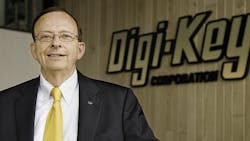Digi-Key’s Mark Larson Talks Industry Change
The recent leadership transition at large electronic components distributor Digi-Key Electronics is complete. Mark Larson has handed off the role of president to Dave Doherty and is now vice chairman of the company’s board of directors—a position he says will allow him to take a more focused approach to certain aspects of the business now that he won’t be busy with its day-to-day management. It’s time to put his 39 years of experience in the industry to use in new ways—a challenge he is more than looking forward to, he said in a recent interview about the leadership change.
“I finally have the luxury to devote my time to areas I see as particularly significant,” said Larson, who joined Digi-Key in 1976 as chief operating officer. “And because of my position I will still be able to marshal the resources internally and externally [to get things done].”
Larson was interviewed for a special Q&A in Electronic Design magazine, in which he was asked to reflect on the changes in the electronic components supply channel over the last 39 years—in particular, how those changes have affected the design engineering community. Larson highlighted three key areas that not only affect the engineering community, but the procurement field as well:
Service. Larson says the greatest change in electronic components distribution since he joined Digi-Key in 1976 is vast improvement in service levels. Faster delivery, better accuracy, and greater access to information and resources are the primary examples. These service levels have improved across the board thanks to the competitiveness of the distribution landscape, a factor that continues to propel the industry forward, he said.
Time to market. The speed at which designers and manufacturing organizations need to get their products to market has never been more intense. As a result, the distributor’s chief role remains helping customers do their jobs better, faster, and more efficiently so they can meet those goals.
Quality. One of his best decisions as Digi-Key’s leader was the early choice to become an authorized distributor of electronic components. Digi-Key started out as a reseller of excess components from a variety of sources, but Larson says he quickly realized that the best way to assure consistency and quality of supply was to secure authorized distribution agreements with component manufacturers. This has never been more important than it is today, as component manufacturers, distributors, and end-users alike struggle to stem the flow of counterfeit parts into the electronic supply chain to avoid product failure in the field. Why buy authorized? Because it’s just not worth the risk to do otherwise, Larson explained.
The electronic components distribution landscape will continue to evolve, and Larson says he expects Digi-Key to remain at the forefront of that change. For more insight from this longtime industry leader, see Electronic Design’s Q&A.
About the Author
Victoria Fraza Kickham
Distribution Editor
Victoria Kickham is the distribution editor for Electronic Design magazine, SourceESB and GlobalPurchasing.com, where she covers issues related to the electronics supply chain. Victoria started out as a general assignment reporter for several Boston-area newspapers before joining Industrial Distribution magazine, where she spent 14 years covering industrial markets. She served as ID’s managing editor from 2000 to 2010. Victoria has a bachelor’s degree in English from the University of New Hampshire and a master’s degree in English from Northeastern University.







